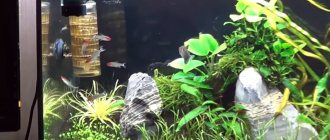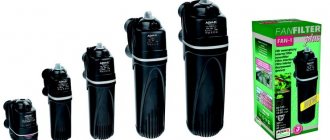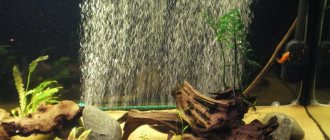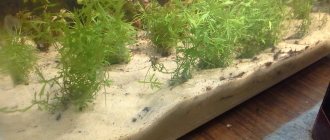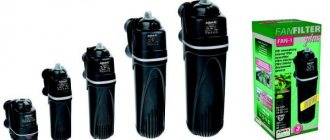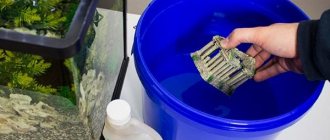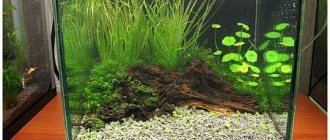Even if such an annoying nuisance happens as an aquarium breakdown, this does not mean that you need to immediately buy a new one. Modern means available on the market allow even a novice aquarist to cope with this problem.
Today there are enough sealants that will help you quickly and reliably repair an aquarium at home and avoid leaks in the future.
The only requirement should be that the sealant is safe for plants and fish. To do this, they must meet certain characteristics.
General requirements for sealant
Any adhesive compositions will work for gluing ordinary household glass, but for aquarium glass you need to choose a special product. Any glue will not work, since aquarium glass has a number of features.
- The bottom and walls experience quite a lot of pressure, especially if the product holds a volume of water of three hundred or more liters. In this regard, the joining seams must be elastic enough not to crack, and completely sealed to withstand the pressure of water masses.
- In addition to water, the joints will be affected by the environment: outside air, temperature fluctuations, ultraviolet rays. Not every adhesive composition will withstand this.
- Aquarium inhabitants: fish, aquarium plants, snails are very susceptible to the chemical components in the glue and this can lead to their death. For example, a sealant with bitumen additives can poison residents. Polyurethane glue will achieve the same result.
The question immediately arises - how to choose the right sealant for these purposes? To do this you need to pay attention to:
- absence of toxic substances such as antibiotics, fungicides, acids, alkalis and dyes;
- How reliable is the adhesive solution and what is the degree of adhesion relative to glass and plexiglass (the material from which the aquarium is made);
- how elastic it is and can adapt to environmental conditions;
- water resistance.
Based on the above, silicone sealant is suitable, which is recommended for use by experienced aquarists.
How to use non-toxic silicone for aquarium
Before starting repairs, we recommend checking that all joints are in place. If you need to empty your aquarium to fix a single leak, a smart move is to immediately check to see if there is another problem area that needs to be re-sealed.
Keep in mind that leaks often originate from the inside rather than the outside because the water puts pressure on the glass.
After a thorough initial site inspection, follow these steps:
- Remove the water by lowering it to a level below the point you are repairing. If necessary, remove the fish to clean and completely dry the aquarium;
- Remove old silicone with a utility knife or other sharp object. If your fish is still in the tank, do not allow any silicone residue to get into the water. Do not remove all the silicone unless you need to replace the entire window in the aquarium;
- Clean the joint with acetone to remove stubborn residue from the glass;
- Starting from the inside, apply beads of aquarium silicone between the joints. Make sure you fill every little crack;
- Repeat application also on the outside, making sure there are no cracks without applying silicone;
- Wait for the glue to harden before adding water again;
- Gradually fill the aquarium, checking the secure fit.
Applying a few drops of silicone to the joint of your aquarium can strengthen the seal, preparing it for the effects of water pressure. Do not forget that this operation must be done both outside and inside.
Types of sealants
Depending on the composition, sealing agents are divided into acrylic, silicone, thiokol, polyurethane, etc. The product should be based on silicone, since other types can be harmful to the inhabitants of the aquarium.
The products are divided into one-component and two-component. The first remedy is more universal and does not require special preparation. The second will need to be prepared by first connecting a number of components.
Small cracks that do not pass through can be sealed with another type of sealant. The exception is acrylic, because it is not moisture resistant and has weak adhesive properties.
You can use butyl compounds, which will help cope with minor defects, but their strength is still reduced.
A broken aquarium must be freed from sand, water stones and other decorative elements, dried thoroughly and glued with epoxy glue, or use “cold welding”. The compositions are safe for fish and vegetation, but you cannot do without emptying the container.
Silicone glue
Silicone sealing mixture used for artificial ponds is briefly called aquarium silicone. The variety has gained great popularity in the aquarium hobby due to its wide range of advantages and benefits.
Before choosing how to glue a crack in a tank, you should find out about the composition of the product used. Aquarium silicone sealant has a complex and rich composition, which includes the following components:
- Rubber and dye.
- Strength multiplier.
- Vulcanizer and adhesive, which ensures strong adhesion of surfaces and drying.
- A plasticizer that gives the product elasticity.
It is important to note that silicone varieties are safe for inhabitants of the underwater world and will not cause any harm to fish, vegetation and shellfish.
Features of choice
When purchasing, pay attention to what type of sealant is - acidic or neutral. The acidic one is marked with the letter “A” on the tube and has a strong vinegar smell.
Neutral has no odor and is perfect for repairing an aquarium at home.
It costs more than acidic and cannot be too cheap. These funds have:
- durability, elasticity and moisture resistance;
- tolerate temperature fluctuations well within the range from -70 to +70C;
- cannot be painted; paint does not stick to seams;
- You cannot apply a new layer without removing the previous one, so you must first clean the surface.
“Pay attention to the color of the sealant you purchase. It’s better to buy colorless ones, but don’t buy colored ones with artificial pigments. Look at the remaining shelf life, this is quite important.
The instructions should also contain a note about the possibility of using this type of glue for aquariums and its safety.”
How to choose
When choosing a sealant, you need to consider the following factors:
- Does it contain harmful substances?
- What color is the composition?
- How long does it take for aquarium sealant to dry?
- Does it contain dyes?
- Is there a “For aquarium” mark on the packaging?
You need to buy a composition for working with an aquarium in trusted stores that can provide documentation for the product. If you accidentally come across a fake, you can lose your fish or significantly spoil the appearance of the tank.
You need to look at the expiration date. When it’s running low, it’s better not to buy it, because the sealant loses its quality over time. For aquariums, you need to buy only high-quality, fresh, properly packaged glue.
Properties and composition of silicone sealant
Silicone sealant (silicone) is used in the construction and household sectors due to its practicality. The composition is based on synthetic rubber, which provides excellent durability. The glue is additionally strengthened with modifiers and plasticizers.
Please note that they are sold clear and dyed. The composition must contain a vulcanizer. A substance necessary to convert the paste into a sufficiently elastic material and adhesive substances that strengthen the connection.
Black silicone
Some believe that the black color used in the product gives it greater strength and durability, the ability to withstand more loads.
However, in terms of composition and adhesive properties, it is no different from the others, and the color color is just an aesthetic indicator.
When applied, a seam of this color looks more attractive and gives the correct geometry to the aquarium. Particularly effective on large aquariums.
Additional Information
ads
We are on VKontakte https://vk.com/tvoy_akvarium31 join us.
The site is for informational purposes only - read only. Select the required items in the MENU. No need to register.
Even the most luxurious aquarium, lovingly populated with exotic inhabitants, is not immune from sudden leaks. It doesn’t matter at all whether the cause is a manufacturing defect or a violation of operating rules, silicone for an aquarium will help to cope with the problem.
Advantages of silicone aquarium sealants
Silicone-based adhesives are recommended for repairing terrariums, aquariums and other transparent containers as they are harmless and non-toxic.
When working with the composition, you do not need to use any special protective equipment, because they do not release toxins.
To determine the drying time of the sealant, you need to check the attached instructions. Basically, the time does not exceed twenty minutes and the product can be used within a day.
A number of other advantages of the product:
- the seam is strong enough because it can withstand mechanical stress weighing more than two hundred kilograms;
- good elastic connection that does not crack over time;
- ease of use and durability.
If the store does not have special aquarium sealants, they can easily be replaced with ordinary silicone glue for dishes and pipelines only without fungicidal and antimicrobial additives.
Aquarium glue: basic requirements
Aquarium glue must guarantee complete safety for fish. Therefore, it is forbidden to buy ordinary sealants for gluing them.
You need to be especially careful with silicone aquarium glue. No matter how the manufacturers insist, any silicone-based adhesive will not work for this purpose.
Therefore, make sure that there is a mark on the tube that the sealant is intended for repairing the aquarium. Otherwise, there is a possibility that the structure of the adhesive will contain components harmful to fish.
This composition must be resistant to humid environments. After all, a crack on a surface that is constantly in contact with water will be repaired. Therefore, the adhesive should not spread or lose its properties over a long period.
Aquarium sealants are characterized by elasticity. After all, they need to withstand a long service life in fairly harsh conditions.
Application technology
In order for aquarium glue to perform its assigned duties, you need to follow several rules for its use. If you decide to use silicone caulk, you can't count on the paint sticking to it. Therefore, be careful not to let the glue get on the metal surface.
Popular manufacturers
You can find a wide variety of sealants on store shelves. They differ mainly in price, quality and composition. Let's look at some brands.
- "Chemlux 9013" is an instant remedy that is durable, durable and can be stored open. The tube is enough for a three-hundred-liter aquarium.
- “Moment Guarantor” is entirely made of silicone. Ideal for all aquarium containers and has good contact with seawater. The seams are sealed and can withstand vibration. It can be used on laminated or glazed glass.
- "Soudal AQ" is a Belgian product that is harmless to aquatic life. In addition to glass, it reliably bonds plastic, wood, ceramics and metal. Water resistant.
- KimTec is a water-resistant product that, when exposed to air, becomes a soft, elastic rubber that can withstand aggressive environments. Suitable for aquarium containers for various purposes, as well as decorative and artistic glass objects.
- “Krass” is an elastic and moisture-resistant sealant mainly used for repairing the external sides of the aquarium. It contains acids, which gives it a sour smell, so the product is left for a day in a room with good ventilation.
- “Titan” is a high-quality elastic Polish product that does not harm fish and shellfish.
The best silicones for aquarium 2021
According to Amazon, the most commonly purchased aquarium sealants are:
Aquarium silicone Den Braven, 300 ml
Resistant to fresh and sea water, high elasticity and transparency. High-quality one-component silicone sealant, specially designed for professional installation and installation work when installing aquariums, terrariums, display cases, and display cases.
- Transparent silicone with excellent adhesion properties to glass without the use of an additional primer.
- Once hardened, permanently elastic, for fresh and sea water, highly resistant for aquariums up to 1000 liters.
Everbuild EVBAQUATR - silicone for aquariums, transparent
High-quality one-component silicone sealant, specially designed for professional installation and installation work during the construction of aquariums.
- Black silicone with excellent adhesion properties on glass without the use of an additional primer.
- High quality thanks to environmentally friendly production in Europe.
Topp Silicone gasket for aquarium
Durable, elastic silicone sealant with high adhesion for elastic waterproofing of aquarium structures, display cases, glass.
Main advantages:
- Safe,
- High adhesive strength,
- Elasticity,
- Excellent adhesion to glass,
- Temperature range: -50°C to +230°C.
- Colors: transparent and black.
If you are selecting a sealant for an aquarium for the first time, be sure to look at the labeling. It is best suited with the inscription “for aquarium”.
Bonding and repairing an aquarium
Repairing an aquarium at home will not cause difficulties if you follow some rules:
- cover the work surface with a protective film;
- use masking tape, moving away from the edges, to protect the glass parts of the aquarium;
- treat the areas to be glued with a degreaser, acetone or alcohol;
- Apply the sealant in a thin layer and carefully level it;
- connect the walls of the container with the bottom in the following sequence: first the front wall, then the right, then the left and finally the back;
- fix the product for the period specified in the description using any tightening means;
- Before the glue dries, remove excess glue with a construction scraper;
- After drying time (approximately 24 hours), fill the container with water, check if the seams are leaking and drain the water.
“If used glass is used when creating an aquarium, they must be thoroughly cleaned of previous adhesive sealants using acetone and a sharp scraper.
Only dry parts are treated with sealant, otherwise the connection will be of poor quality.”
What to do with a cracked aquarium? The order is:
- inspect the leak site and remove condensate;
- move fish and ornamental plants to another place and pour out the liquid;
- dry the cracked area and degrease it;
- seal the defect with sealant and carefully level the seam at the gluing site with a spatula;
- wait until completely dry.
Instructions for sealing an aquarium with your own hands
Gluing the walls of aquariums is carried out according to the following algorithm:
- The area where the glue is applied is cleaned first with a sharp blade and then with degreasing compounds.
- The glass is sealed with masking tape with a slight indentation from the edges.
- The adhesive composition is applied in an even layer.
- The walls are pressed to the bottom with little force and left in this form for a day.
During work, excess glue must be removed immediately. If there is a need to repair the aquarium, then you should pour sealant into the crack on both sides and push it inward. After this, the remaining glue must be cleaned off using a rubber spatula.
The appearance of bubbles - control measures
Sometimes inaccurate gluing of surfaces leads to the entry of air and the formation of bubbles.
By adding a little sealant to the seam and tightening the parts tightly, they can be eliminated. The air gap can be removed with a rubber spatula. If a problem is detected when the silicone has already set to the surface, it is enough to pierce the bubbles with a needle.
If the seam turns out to be mostly of poor quality, then it is better to re-glue it.
Tips for working with glue
To remove excess glue that has already dried a little, you can use table vinegar. Moisten a cloth with it and carefully wipe the base. When repairing an old aquarium, you should always remove the fish, even if the crack is minimal. For beginners, when creating a new aquarium, it is recommended to use only transparent sealants and a special glue gun - it is easier to use than applying glue by hand.
The appearance of bubbles - control measures
Air can form when parts are not carefully glued together or the adhesive line is applied carelessly. You can remove bubbles by adding sealant and tightening the walls of the aquarium. You can also remove air by running a rubber roller along the seam.
It happens that the problem is identified after the silicone has hardened. Then the balloons are pierced with a needle. If there are large defects, you will have to open and re-glue the seam.
